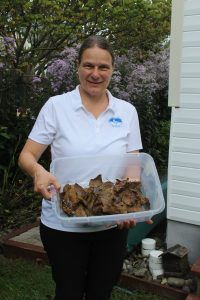
Verena Chase of Assateague Coastal Trust Coast Kids program holds a container of leaves and small creatures from her garden.
By Cindy Hoffman, Staff Writer
(Oct. 12, 2023) As the leaves begin to fall and gardens turn from green to rust, gold and yellow, many people are looking towards fall cleanup.
But a lot of what gardeners and homeowners do to clean up their yards in fall can affect the homes of others. Think birds, salamanders, spiders and other insects.
So instead of trimming up your flowers and raking the leaves out of your garden and off your yard, consider a simpler alternative. Leave them be.
Fallen leaves and seed pods from flowering plants are habitat and food for many species.
“Don’t cut back perennials that provide seeds for birds,” Verena Chase, the director of the Coast Kids Program for Assateague Coastal Trust, said.
The black-eyed Susan, cone flower, native sunflower, sedum and many other flowering plants that bloom over the summer all have seed heads in fall that are an abundant food source for birds like cardinals, chickadees, goldfinches and many other birds.
Right now, Chase has an abundance of asters in bloom in her garden. The native bees are loving the flowers and once they die, Chase said she will not cut them back until spring to provide seed and shelter for the birds through the winter.
Keeping those faded blooms intact through springtime adds interest to the garden and keeps feathered friends fed, she said.
Chase also recommends gardeners keep leaves in the garden through the fall and winter.
“The leaves add nutrients back into the soil and fertilize the soil naturally,” Chase said. “The leaves also provide cover and habitat for a huge number of creatures that live there.”
Earthworms shred dead leaves as they feed on bacteria and fungi. They enhance the soil structure and let air in the soil as they burrow through. In addition, their castings are rich in nutrients for plants, creating a natural fertilizer. Slugs and snails also live in the leaf litter.
A handful of leaves picked up by Chase in her yard had numerous small spiders and other tiny insects hiding in it, including springtails, which are tiny animals that live in the leaf litter. They are unique in that they can jump by folding their tail under their body and then rapidly releasing the tension.
Wrens, cardinals and robins will pick through the leaf litter to catch insects, while salamanders, toads and turtles take cover in the garden during winter months.
As for leaves on the lawn, these can be shredded with a lawnmower and left on the lawn as natural fertilizer, deposited in the garden or put in a compost pile for next year’s garden.
“You can save emissions by not putting leaves in the trash,” Chase said.
She does recommend cleaning out bird houses in the fall. Birds will not use the houses during the winter and cleaning them out will ensure fleas are not present when the houses are considered during spring nesting season.
Chase has a number of native bee breeding boxes in her yard, made by participants of her Coast Kids program. Native bees are solitary, are not aggressive and overwinter as larvae. She will bring the boxes into a sheltered area so they are less susceptible to freezing temperatures once it gets cold.
So, instead of blowing out all of the leaves, keep leaves in the garden and keep the birds and other creatures housed and fed through the winter.
